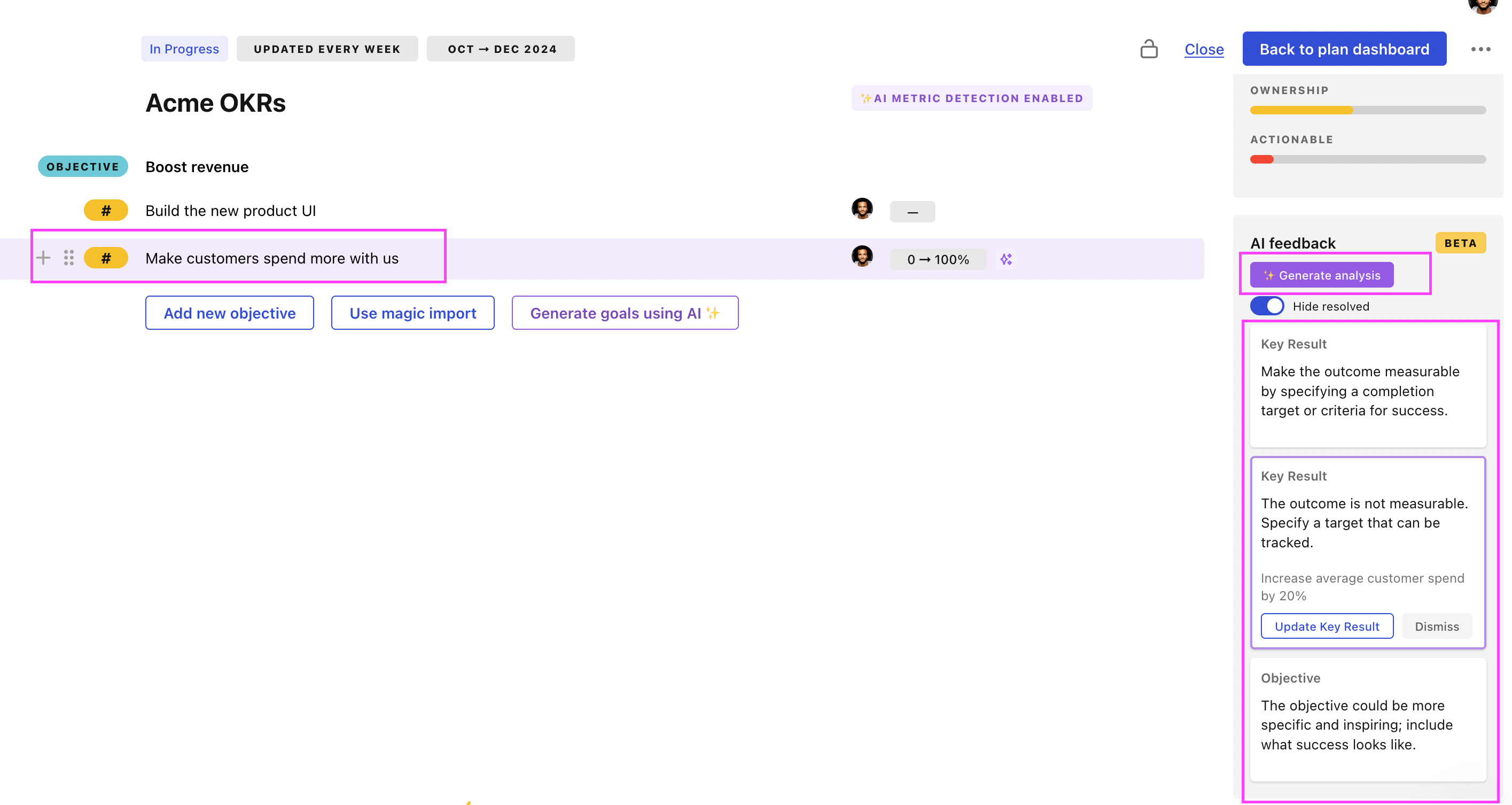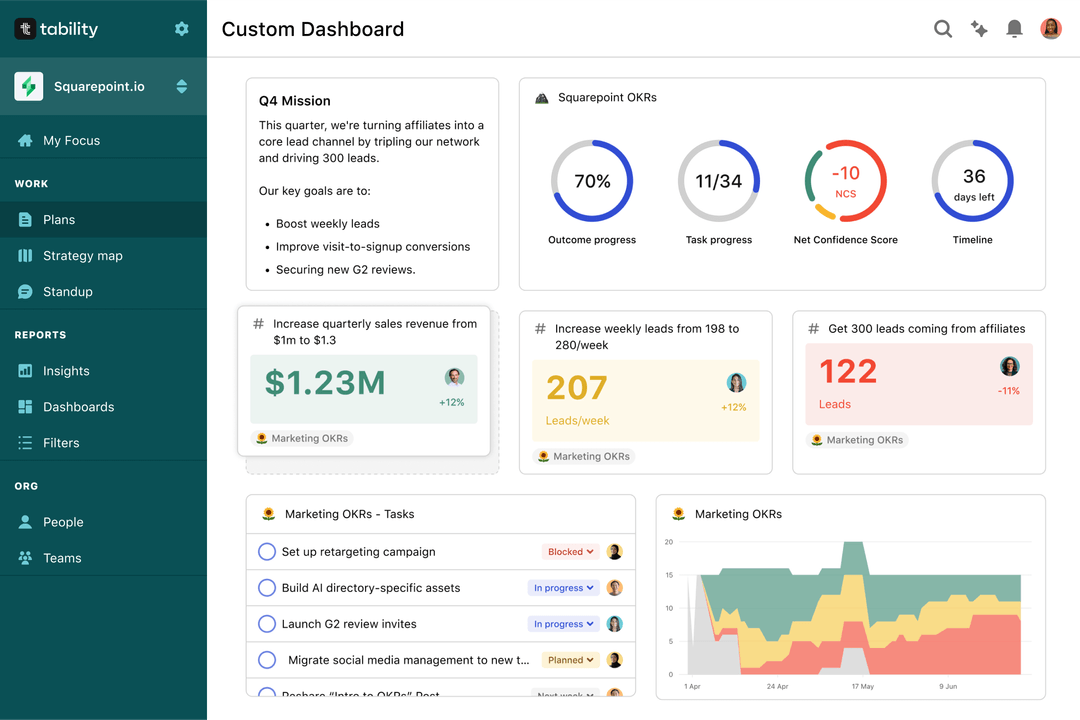Tability is a cheatcode for goal-driven teams. Set perfect OKRs with AI, stay focused on the work that matters.
What are Profitability OKRs?
The Objective and Key Results (OKR) framework is a simple goal-setting methodology that was introduced at Intel by Andy Grove in the 70s. It became popular after John Doerr introduced it to Google in the 90s, and it's now used by teams of all sizes to set and track ambitious goals at scale.
Creating impactful OKRs can be a daunting task, especially for newcomers. Shifting your focus from projects to outcomes is key to successful planning.
We've tailored a list of OKRs examples for Profitability to help you. You can look at any of the templates below to get some inspiration for your own goals.
If you want to learn more about the framework, you can read our OKR guide online.
The best tools for writing perfect Profitability OKRs
Here are 2 tools that can help you draft your OKRs in no time.
Tability AI: to generate OKRs based on a prompt
Tability AI allows you to describe your goals in a prompt, and generate a fully editable OKR template in seconds.
- 1. Create a Tability account
- 2. Click on the Generate goals using AI
- 3. Describe your goals in a prompt
- 4. Get your fully editable OKR template
- 5. Publish to start tracking progress and get automated OKR dashboards
Watch the video below to see it in action 👇
Tability Feedback: to improve existing OKRs
You can use Tability's AI feedback to improve your OKRs if you already have existing goals.
- 1. Create your Tability account
- 2. Add your existing OKRs (you can import them from a spreadsheet)
- 3. Click on Generate analysis
- 4. Review the suggestions and decide to accept or dismiss them
- 5. Publish to start tracking progress and get automated OKR dashboards

Tability will scan your OKRs and offer different suggestions to improve them. This can range from a small rewrite of a statement to make it clearer to a complete rewrite of the entire OKR.
Profitability OKRs examples
We've added many examples of Profitability Objectives and Key Results, but we did not stop there. Understanding the difference between OKRs and projects is important, so we also added examples of strategic initiatives that relate to the OKRs.
Hope you'll find this helpful!
OKRs to achieve profitability by reducing operational costs by 20% in the current fiscal year
ObjectiveCut operational costs to achieve profitability
KRReduce employee overtime costs by 30%
KRImplement automation processes to reduce manual labor costs by 20%
KRDecrease inventory storage costs by 25%
KRLower utility expenses by 15% through energy-efficient measures
OKRs to increase company profitability
ObjectiveIncrease company profitability
KRAchieve a 10% reduction in operating costs through efficiency improvements
Identify wasteful practices in the current operational process
Implement new efficiency-enhancing technologies
Train staff on cost-saving practices and procedures
KRIncrease net revenue by 15% via new customer acquisition strategies
Conduct market research to identify potential customer segments
Offer incentives for referrals to generate new clients
Develop and implement a targeted digital marketing campaign
KRImplement cost-saving measures to decrease overhead expenses by 8%
Develop strategies to reduce miscellaneous office expenditures
Review and analyze current overhead expenses in detail
Optimize energy usage to minimize utility bills
OKRs to enhance business profitability through data analysis
ObjectiveEnhance business profitability through data analysis
KRIncrease accuracy of forecasting models used by sales team by 15%
Train sales team on data interpretation and prediction techniques
Analyze past forecasting models for discrepancies and errors
Invest in advanced predictive analytics software
KRDevelop data strategies for 3 new business units to aid decision making
KRAchieve 20% reduction in costs through improved predictive models
Develop and implement advanced predictive models
Monitor and measure cost reductions frequently
Continually optimize models to improve accuracy and efficiency
OKRs to enhance project profitability and delivery efficiency
ObjectiveEnhance project profitability and delivery efficiency
KRReduce project overruns by at least 30%
Enhance project management training for staff
Establish a strong pre-project planning protocol
Implement stringent project timeline tracking
KREnsure 90% of projects are delivered within budget allotment
Provide regular budget training for project managers
Conduct regular financial reviews of ongoing projects
Implement stringent budget monitoring and control measures
KRBoost on-time project completion rate to 95%
Offer incentives for meeting project deadlines timely
Implement project management software for tracking deadlines
Conduct regular progress report meetings with team
OKRs to enhance overall company profitability
ObjectiveEnhance overall company profitability
KRIncrease net profit margin by 10% through cost reduction strategies
Optimize energy usage to reduce utility bills
Renegotiate supplier contracts for better rates
Identify and eliminate non-essential operational costs
KRBoost total revenue by 15% by diversifying product offerings
Implement marketing strategies for new products
Develop and prototype promising product ideas
Research market trends to identify potential new product areas
KRGrow customer retention rate by 8% through improving customer satisfaction
Implement proactive customer service via phone or email
Offer special loyalty programs or discounts
Conduct customer satisfaction surveys regularly
OKRs to increase overall business profitability
ObjectiveIncrease overall business profitability
KREnhance product pricing to boost gross profit by 15%
Analyze competitors' pricing strategies for comparable products
Implement cost reduction measures to increase profit margins
Adjust pricing based on product demand and value perception
KRImplement process optimization strategies to cut operational costs by 7%
Identify and analyze areas with high operational costs
Evaluate the impacts regularly and make adjustments
Develop and apply process optimization strategies
KRAttain a 10% net profit margin by improving cost efficiency
Identify unnecessary costs and eliminate them
Implement more cost-effective processes and procedures
Train employees on cost efficiency practices
OKRs to boost training effectiveness for improved profitability
ObjectiveBoost training effectiveness for improved profitability
KRIncrease revenue per employee by 15% following completed training
Continually adjust training based on performance metrics feedback
Implement comprehensive and effective training programs for all employees
Track and evaluate employees' productivity post-training
KRImprove post-training efficiency by 30% in daily tasks
Implement improved training methods focused on job-specific tasks
Consistently track progress and provide feedback on improvements
Identify areas of inefficiency in daily tasks post-training
KRIncrease training completion rate by 20%
Initiate incentives for timely training completion
Provide structured support and resources for trainees
Implement engaging, interactive elements in training modules
OKRs to amplify revenue growth and enhance company profitability
ObjectiveAmplify revenue growth and enhance company profitability
KRReduce operational expenses by 10%
Implement energy-saving practices to lower utility costs
Negotiate with suppliers for better pricing deals
Streamline processes by adopting automation technology
KRBoost customer retention rate by 20%
Conduct personalized email marketing campaigns
Enhance customer service interactions and responsiveness
Implement a loyalty rewards program for repeat customers
KRAchieve a 15% increase in total sales volume
Develop and implement a comprehensive marketing strategy
Strengthen customer engagement via social media
Improve product presentation on sales platforms
OKRs to establish profitability foundations
ObjectiveEstablish profitability foundations
KRIncrease sales revenue by 25%
Develop and launch new product lines to attract customers
Enhance customer service to improve client retention rates
Implement a targeted marketing campaign to boost product awareness
KRReduce operational costs by 10%
Streamline processes to eliminate waste and improve productivity
Increase energy efficiency to lower utility bills
Review all supplier contracts for potential cost-saving opportunities
KRImprove net profit margin by 15%
Implement cost reduction strategies across all operational departments
Streamline supply chain to reduce unnecessary expenditures
Increase product prices without impacting customer demand
OKRs to increase company's overall profitability
ObjectiveIncrease company's overall profitability
KRBoost sales by 10% to enhance revenue
Improve after-sales service to promote customer loyalty
Implement an upselling strategy to increase average transaction value
Enhance digital marketing tactics to expand customer reach
KRRaise net profit margin by an additional 2%
Implement measures to reduce operational and production costs
Boost sales through improved marketing strategies
Increase pricing of products or services strategically
KRMinimize operating costs by 5% through efficiency measures
Decrease unnecessary material waste production
Streamline processes to reduce labour costs
Implement energy-saving equipment and lighting fixtures
Profitability OKR best practices
Generally speaking, your objectives should be ambitious yet achievable, and your key results should be measurable and time-bound (using the SMART framework can be helpful). It is also recommended to list strategic initiatives under your key results, as it'll help you avoid the common mistake of listing projects in your KRs.
Here are a couple of best practices extracted from our OKR implementation guide 👇
Tip #1: Limit the number of key results
Having too many OKRs is the #1 mistake that teams make when adopting the framework. The problem with tracking too many competing goals is that it will be hard for your team to know what really matters.
We recommend having 3-4 objectives, and 3-4 key results per objective. A platform like Tability can run audits on your data to help you identify the plans that have too many goals.
Tip #2: Commit to weekly OKR check-ins
Setting good goals can be challenging, but without regular check-ins, your team will struggle to make progress. We recommend that you track your OKRs weekly to get the full benefits from the framework.
Being able to see trends for your key results will also keep yourself honest.
Tip #3: No more than 2 yellow statuses in a row
Yes, this is another tip for goal-tracking instead of goal-setting (but you'll get plenty of OKR examples above). But, once you have your goals defined, it will be your ability to keep the right sense of urgency that will make the difference.
As a rule of thumb, it's best to avoid having more than 2 yellow/at risk statuses in a row.
Make a call on the 3rd update. You should be either back on track, or off track. This sounds harsh but it's the best way to signal risks early enough to fix things.
Save hours with automated Profitability OKR dashboards

Quarterly OKRs should have weekly updates to get all the benefits from the framework. Reviewing progress periodically has several advantages:
- It brings the goals back to the top of the mind
- It will highlight poorly set OKRs
- It will surface execution risks
- It improves transparency and accountability
Most teams should start with a spreadsheet if they're using OKRs for the first time. Then, you can move to Tability to save time with automated OKR dashboards, data connectors, and actionable insights.
How to get Tability dashboards:
- 1. Create a Tability account
- 2. Use the importers to add your OKRs (works with any spreadsheet or doc)
- 3. Publish your OKR plan
That's it! Tability will instantly get access to 10+ dashboards to monitor progress, visualise trends, and identify risks early.
More Profitability OKR templates
We have more templates to help you draft your team goals and OKRs.
OKRs to maintain continuous operation of critical facilities and equipment
OKRs to successfully execute SEO projects for improved online visibility
OKRs to boost Sales Performance Through Strategic Leadership
OKRs to enhance inter-departmental collaboration for effective social media operations
OKRs to effective implementation of DevSecOps in the team
OKRs to increase efficiency in customer support process